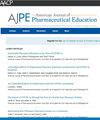Bringing the Patient Voice into Workplace-Based Assessment of Pharmacy Learners: An Interpretive Description Study
IF 3.8
4区 教育学
Q1 EDUCATION, SCIENTIFIC DISCIPLINES
引用次数: 0
Abstract
Objectives
This study sought to explore how patients view their involvement in pharmacy learner assessment by comparing and contrasting patients’ and pharmacy learners’ perspectives on learner skills patients are capable of providing feedback on.
Methods
We conducted a qualitative study informed by interpretive description methodology and situated in a pharmacist-led clinic that serves as a teaching site for pharmacy learners. We interviewed 10 patients who were cared for by a pharmacy learner and 10 pharmacy learners who were completing clerkship training. Data analysis was iterative and used a thematic approach.
Results
All patient participants expressed interest in giving feedback on pharmacy learner skills while learners regarded patient feedback as an asset to their educational journey. Overall, we identified 2 overarching themes (1) Humanistic aspects of pharmacy learner care; and (2) Intrinsic aspects of pharmacy learner care. There was marked divergence when comparing and contrasting patients’ and pharmacy learners’ data. Subthemes further revealed that humanistic aspects include rapport, simple language, and active listening as pharmacy learner skills patients felt they could assess. Conversely, pharmacy learners expected patients to predominantly assess their intrinsic pharmacy skills including knowledge and optimization of health.
Conclusion
This study provides insight into how real patients could participate in the assessment of pharmacy learners and how this participation was perceived by learners themselves. We encourage pharmacy educators to incorporate patient perspectives into the content/curricula of their training programs as an inclusive approach to learner assessment. We also recommend developing a patient feedback tool informed by our study findings.
将病人的声音带入药学学习者的工作场所评估:一项解释性描述研究。
目的:本研究旨在通过比较患者和药学学习者对患者能够提供反馈的学习技能的看法,探讨患者如何看待他们参与药学学习者评估的问题:本研究旨在通过比较和对比患者和药剂学学习者对患者能够提供反馈的学习者技能的看法,探讨患者如何看待他们参与药剂学学习者评估的问题:我们采用解释性描述方法进行了一项定性研究,研究地点位于一家由药剂师主导的诊所,该诊所是药剂学学习者的教学场所。我们采访了十名由药剂学学员护理的患者和十名正在完成实习培训的药剂学学员。数据分析采用迭代和主题方法:结果:所有参与调查的患者都表示有兴趣对药剂学习者的技能提出反馈意见,而学习者则认为患者的反馈意见是他们教育历程中的宝贵财富。总体而言,我们确定了两个首要主题:1)药剂学学员关怀的人文方面;2)药剂学学员关怀的内在方面。在对患者和药剂学习者的数据进行比较和对比时,发现了明显的分歧。分主题进一步显示,人文关怀方面包括融洽的关系、简单的语言和积极的倾听,这些都是患者认为他们可以评估的药学学习者技能。相反,药学学习者希望患者主要评估他们的内在药学技能,包括知识和优化健康:本研究深入探讨了真实患者如何参与对药学学习者的评估,以及学习者自己如何看待这种参与。我们鼓励药学教育者将患者的观点纳入其培训计划的内容/课程中,作为一种包容性的学习者评估方法。我们还建议根据我们的研究结果开发患者反馈工具。
本文章由计算机程序翻译,如有差异,请以英文原文为准。
求助全文
约1分钟内获得全文
求助全文
来源期刊
CiteScore
4.30
自引率
15.20%
发文量
114
期刊介绍:
The Journal accepts unsolicited manuscripts that have not been published and are not under consideration for publication elsewhere. The Journal only considers material related to pharmaceutical education for publication. Authors must prepare manuscripts to conform to the Journal style (Author Instructions). All manuscripts are subject to peer review and approval by the editor prior to acceptance for publication. Reviewers are assigned by the editor with the advice of the editorial board as needed. Manuscripts are submitted and processed online (Submit a Manuscript) using Editorial Manager, an online manuscript tracking system that facilitates communication between the editorial office, editor, associate editors, reviewers, and authors.
After a manuscript is accepted, it is scheduled for publication in an upcoming issue of the Journal. All manuscripts are formatted and copyedited, and returned to the author for review and approval of the changes. Approximately 2 weeks prior to publication, the author receives an electronic proof of the article for final review and approval. Authors are not assessed page charges for publication.

 求助内容:
求助内容: 应助结果提醒方式:
应助结果提醒方式:


